How To Get The Most Out of Companies House Data | 2021
Category: Uncategorized
Companies House is a government-run organisation that incorporates and dissolves limited companies in the United Kingdom, and holds all kinds of company information in accordance with the Companies Act. It registers basic company details and director information and creates a public record on Companies House WebCHeck, amongst other online services. Millions of professionals use this register of companies and the financial, structural and event-based data held to inform business decisions on a daily basis. The Companies House website can be found at https://www.gov.uk/get-information-about-a-company.
Companies House data is incredibly valuable, but the framework it sits within can be difficult to use. Critically, Companies House is lacking in vital functionality, with a very limited search tool and almost all data stored within images. This means the task of extracting data costs a lot of time, is frustrating, and often means missing out on insights.
Through the Beauhurst platform, we provide greater searchability and transparency of all the data on Companies House. We also provide more detailed data on over 32,000 of the UK’s most exciting, high-growth companies, drawing on thousands of sources to build in-depth company profiles for each. This means you can quickly research known companies, identify lists of companies without knowing about them first, and be alerted to key changes easily.
As such, we’re very familiar with the inner workings of Companies House, its functionality and all the varieties of data you can access. In this article, we’ll answer some common questions of anyone traversing the site, the types of data you can find and the best ways to get to them, highlighting some of the strengths and weaknesses as we go. Where there are limitations to the services Companies House provides, we’ll outline the solutions that Beauhurst offers.
This is a guide for people searching for companies, analysing their filings and performing due diligence on directors. Companies House has its own guides for those of you looking to update your company or individual profile.
Want to skip straight to Beauhurst functionality, and how it can help you get the most out of Companies House data? Book a demo and we’ll be in touch right away. Otherwise, let’s get started!
Contents
1. The Basics of Companies House
- Where does Companies House sit within the government?
- How many businesses are registered on Companies House?
- What types of businesses can you find on Companies House?
- How up to date is Companies House data?
- How accurate is Companies House data?
2. Companies House Company Profiles
- SIC Codes
- Incorporation date
- Company status
- Registered address
- Company filing history and key filings
3. Companies House People and Director Profiles
- Company roles
- Personal shareholdings
- Search for a company
- Search for a Director
- Companies House Services (CHS)
- Companies House Beta
- Companies House WebCHeck service
The Basics of Companies House
Where does Companies House sit within the government?
Companies House is headquartered in Cardiff, where company registrations for England and Wales are carried out. The Edinburgh office handles registrations in Scotland, whilst the Belfast office takes care of those in Northern Ireland. An additional office in London provides search services, and documents can be delivered there. The organisation is sponsored by and sits within the Department for Business, Energy and Industrial Strategy.
How many businesses are registered on Companies House?
As of October 2021, there are 4.99 million businesses on the Companies House register. More than 780,000 businesses were incorporated in 2020 alone. All of the data on these companies, plus powerful filtering tools to navigate the dataset, can be accessed through Beauhurst’s All Company Data add on.
Want to search across all companies in the UK based on their financials, location, and sector?
The Beauhurst platform allows you to combine all kinds of search criteria to find the most relevant companies for you. Try it today for free.
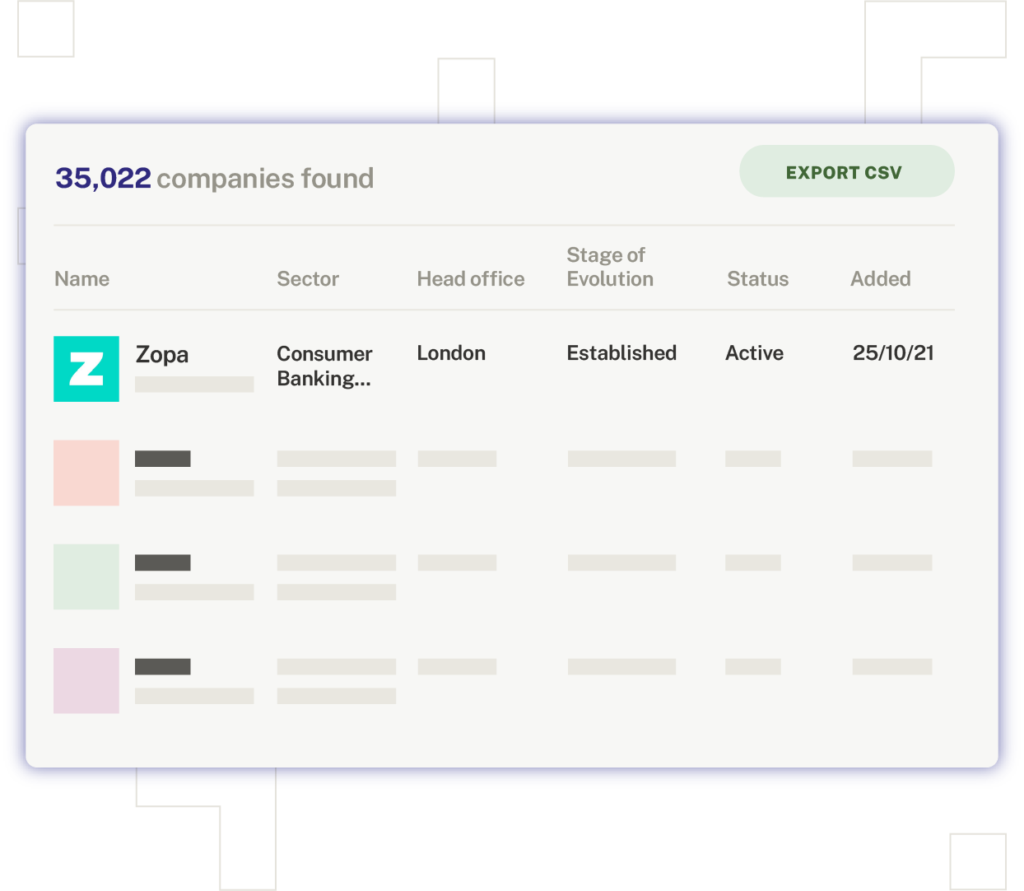
What types of businesses can you find on Companies House?
All businesses, including private and public companies, are required to be incorporated and registered with Companies House. From startups and small businesses, large enterprises and corporates—every company registered in the UK will have a short profile on the government system.
This includes but is not limited to:
- Public limited companies
- Private companies limited by shares
- Private unlimited companies
- Limited liability partnerships
- Limited partnerships
How up to date is Companies House data?
Most forms that are required by Companies House have a filing deadline between 14 and 30 days, and up to 9 months for annual accounts. In light of the coronavirus pandemic, UK companies have been able to apply for a three-month extension to the annual deadline for filing their accounts and reports. Companies can be fined or struck off the register if they don’t send accounts or confirmation statements to Companies House, with a first Gazette notice three months prior.
We can’t make data sourced from Companies House any more up to date on the Beauhurst platform, but we do make sure that our tracked company profiles are regularly reviewed and refreshed.
All of our tracked company profiles are reviewed on a 28 day cycle, so that you know the data is as up to date as possible, and make important decisions with confidence. If something doesn’t look quite right, our subscribers can send a message straight to the data quality team, who will investigate and update the user accordingly.
How accurate is Companies House data?
As Companies House is a government-run body, we would all like to think that the information that’s submitted is accurate and reliable. But the responsibility of this is down to the company, not Companies House.
Companies House itself “does not verify accuracy of information filed”, which means that incorrect information within filings can and will still be filed and uploaded.
This of course applies to the Companies House data that we use on the Beauhurst platform—there aren’t many places we can check information against. But we make sure to signpost when things look a little off.
For example, when a company files an SH01 form, indicating that they have received external investment, our data curators will pull out and input the key info into our systems, which calculate a valuation for the company based on the number of shares and the amount they have been sold for. In some cases, the resulting company valuation may look rather ridiculous.
In this instance, we obviously can’t guess what the correct information is. Instead, we tag the data with a confidence level to highlight that it should be treated with caution.
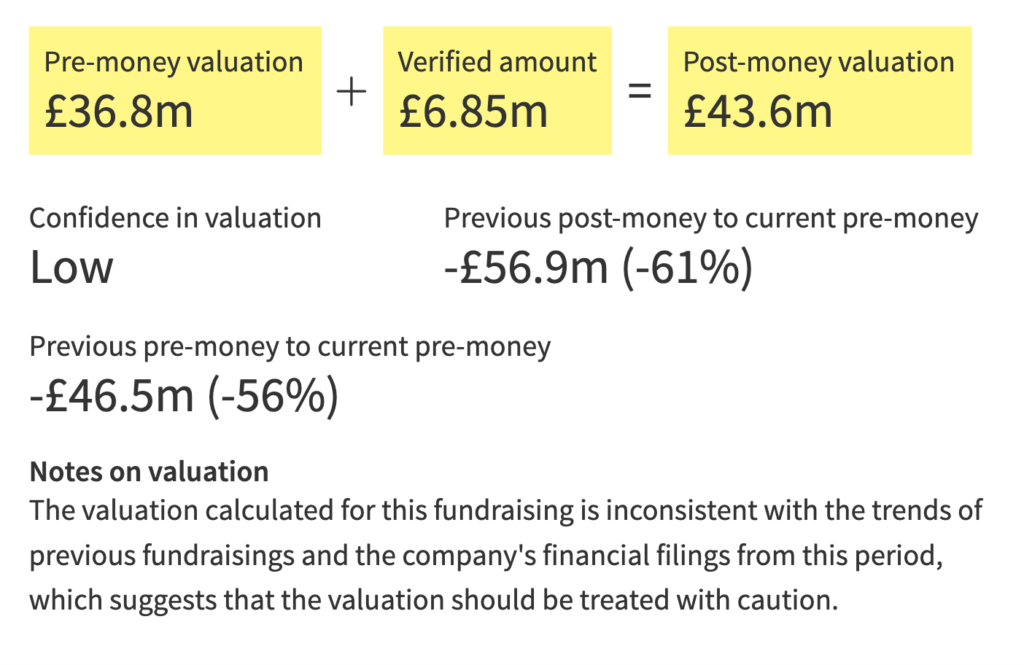
Companies House company profiles
Each registered company has a short profile which you can view at:
https://find-and-update.company-information.service.gov.uk/
Type the company name into the search bar to find what you’re looking for (more on this search function later), and click on the relevant result.
You’ll be taken to the company overview, where you can see the company registration number, registered office address, incorporation date, the company type and status. You’ll also be able to see which sector the company operates in, using the Standard Industrial Categorisation (SIC) codes. Let’s take a deep dive into each of these…

SIC Codes
Company directors can choose from over 600 of these codes to clarify the nature of their business. Usually, one SIC code is sufficient, but businesses can choose up to four. From Banks (64191) to Retail sale via mail order houses or via Internet (47910), and manufacture of beer (11050). These indicate the activities of each business.
Things to be cautious about…
SIC codes can be pretty useful descriptors of companies, but they’re not without limitations.
Despite covering a range of business operations, these codes are decades old and are only revised sporadically. Since 1948 the classification has been revised in 1958, 1968, 1980, 1992, 1997, and 2003. Needless to say, technology has changed a lot since the in the 21st century, so whilst the manufacture of footwear (15200), renting of video tapes and disks (77220), and raising of camels and camelids (1440) are covered, fintech, artificial intelligence, blockchain—and almost every other 21st century sector or activity—are not.
These tech sectors are often categorised under large umbrellas such as ‘Other information technology service activities (62090)’, Web portals (63120), or ‘Business and domestic software development (62012)’.
In addition, some of the SIC codes don’t reference sectors at all. Instead they describe the status of the company (or lack thereof). For example, dormant (99999) or non-trading (74990).
At Beauhurst, we tag high-growth companies with our own matrix, which spans every sector and the intricacies within them. As technology diversifies, we add in new sectors and buzzwords to accommodate—from 3D printing to quantum technology—and everything in between.
And, unlike Companies House, we’re tracking and regularly reviewing the progress of these companies. So we can reflect a change in operations with replacement or additional sectors and buzzwords.
Incorporation data
This refers to the data that the company was first registered with Companies House. This is useful if you’re interested in how long the company has been running for, and benchmarking its progress with similar age companies.
Things to be cautious about…
The date that a business was added to the register often isn’t the date that it started trading.
Sometimes founders will ‘reserve’ a company name several months before they start trading, with the incorporation date appearing before the actual founding date. In other instances, a company group will be made up of multiple legal entities. The ultimate parent of the company (or the “common sense company”) may have been incorporated after the other legal entities saw significant traction.
For example, PaymentSense was first incorporated in 2008, but is currently funneling activity and filing primary accounts under another legal entity, Hurricane Noteco Limited, which was only incorporated in 2016. In this case, the incorporation date of Hurricane Noteco Limited does not reflect the true founding date of the company.
At Beauhurst, we show the date a company was founded, as well as the legal date of incorporation, which can be misleading about the company’s true age.
Company status
A business’s Companies House status indicates its legal status, rather than its trading status.
There are a number of different statuses, but these are the most common:
- Active – a company will be marked as active as soon as it is incorporated and added to the register. Even if the company is dormant (i.e. not actually trading) it can still be marked as active.
- Administration – when a company can’t pay its debts it can file for administration, which will offer legal protection from creditors. It will need to appoint a licensed insolvency practitioner, who will take control of the company and its assets, and try to prevent it from going into liquidation. If this isn’t possible, administrators will use remaining assets to repay as much debt as possible.
- Liquidation – The business has stopped operating and is no longer employing people. Assets are used to pay off debts, and any remaining money will go to shareholders.
- Dissolution – the company no longer exists as a legal entity. This is not the same process as liquidation, because only solvent companies can be dissolved.
Generally the company files for administration or liquidation themselves, but in some cases the courts can order this process if the company cannot pay its creditors.
Things to be cautious about…
Of course, as legal classifications there’s usually a lot more detail behind these statuses. A company may make an announcement that they’re ceasing operations, but might not strike the legal entity off the register for a few months.
At Beauhurst, we track the status of a business through Companies House, but also categorise each of our core, high-growth businesses by ‘stage of evolution’. This means that you can see if a company is in fact ‘dead’ before it goes through the legal proceedings. It also adds a lot more colour to the ‘active’ status, showing whether a company is in seed, venture, growth or the established stage of evolution. These are manually assigned to each company based on 40+ criteria, to present a holistic outline of each companies’ position. Read more about each company category here.
Registered address
The registered company address is the official location where letters, notices and reminders can be delivered. This is often the accountant’s office, or the personal address of the director, rather than where the company itself is located. But you can usually find this out through a company’s website
At Beauhurst, we log a primary location as the company’s head office. We also hold data on all other trading addresses.
Company filing history
Navigate to the Filing history tab and you’ll see a list of all the company’s filings in reverse chronological order with a date of filing, description, and a link to download the PDF for free. You can also see the filing code if you tick the show filing type box.
Above the list you’ll see some categories you can filter by, to filter down the filing(s) that you’re looking for.
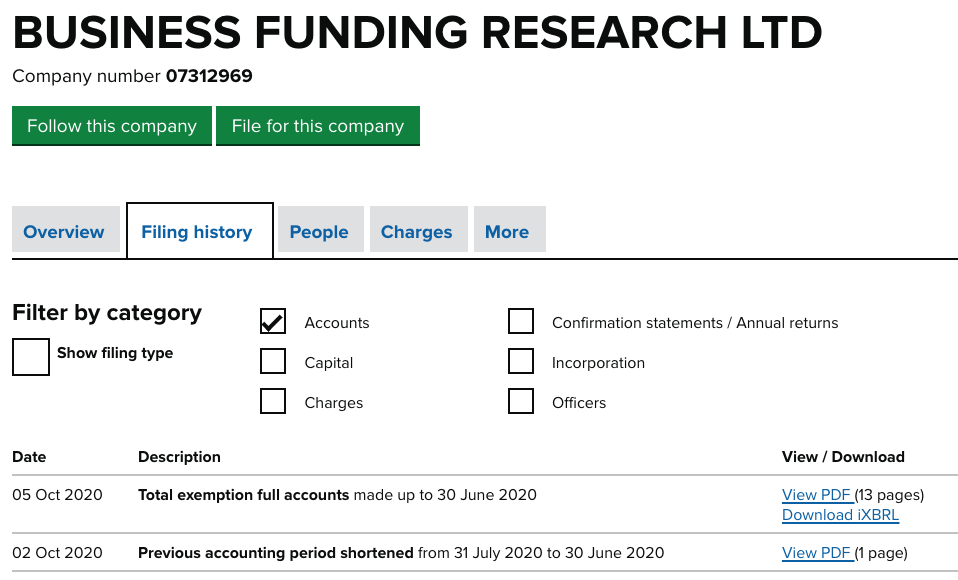
Things to be cautious about…
You can freely download any of these filings very easily, and find lots of information on a company, its directors, and its financial performance. But this data is all stored within PDFs saved as images, which makes sifting through them pretty difficult. Unfortunately, you won’t be able to “Ctrl-F” your way to the exact phrase or figure you’re looking for, and may have to dig around for quite some time.
On top of this, filings don’t have a standard template. Each one will look different, and even the same filings will look different between companies, or between different accounting periods for the same company. That makes it incredibly taxing to scan through documents and compare them side by side.
At Beauhurst, we store the information from financial filings as structured text and present it in a standardised, digestible format. This can drastically reduce the time you spend finding the information that you need. And, as it’s all in text format, you can copy and paste it too. Or, if you want a copy of the whole document, you can export it into a spreadsheet.
Sample of Monzo’s financial accounts on Companies House
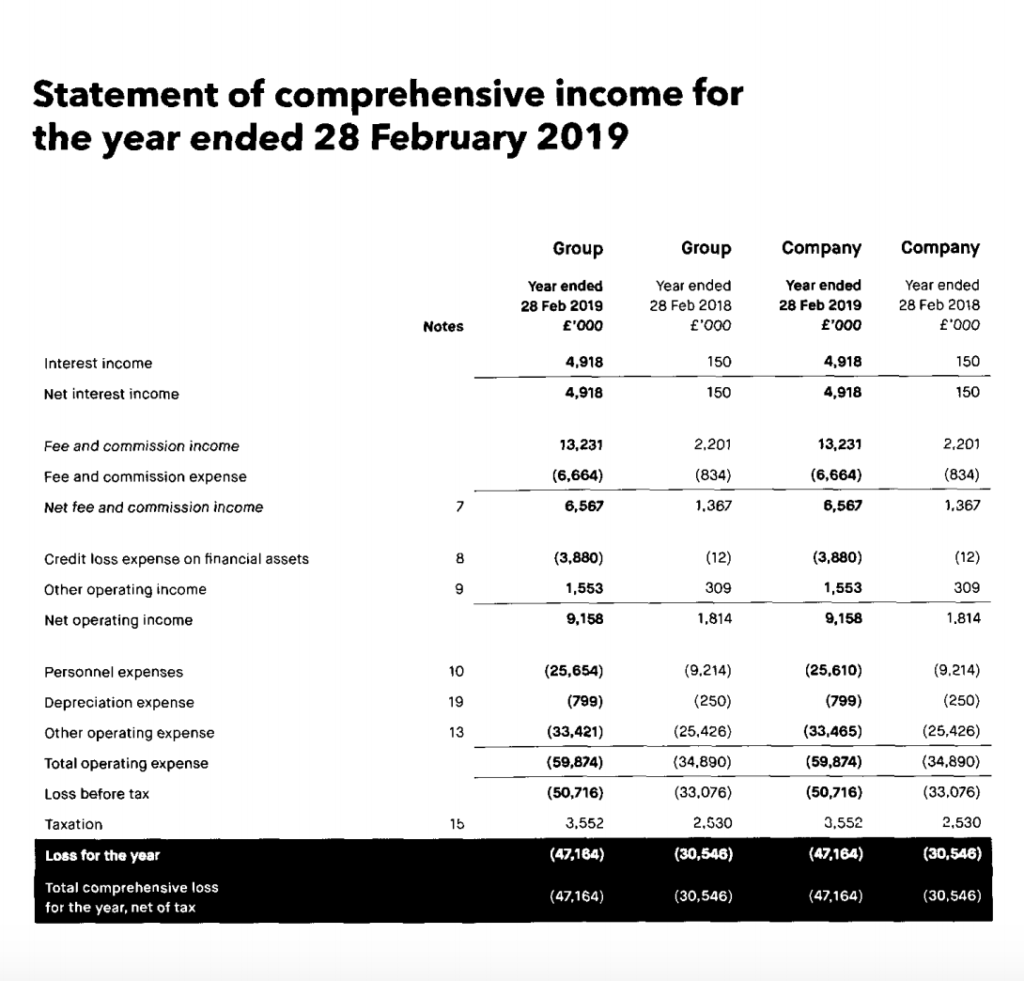
Monzo’s full financial accounts on Beauhurst
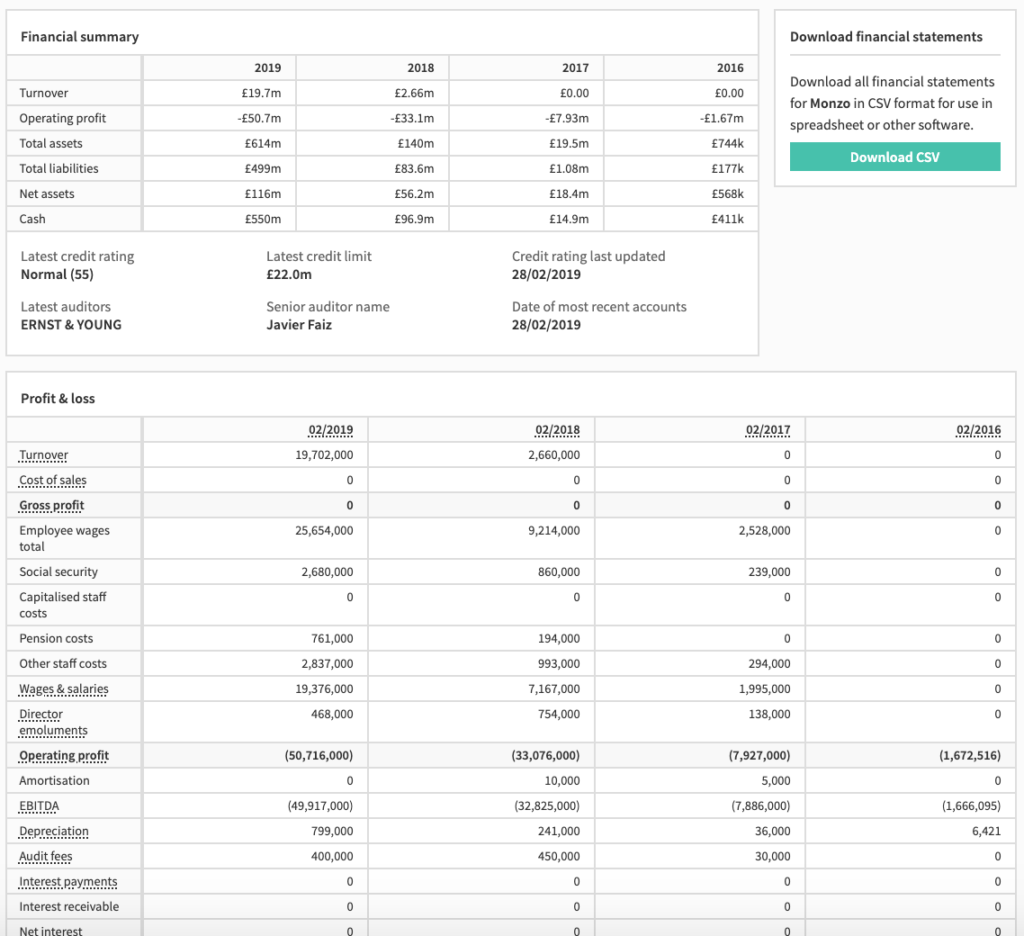
Annual accounts (Form AA)
Annual accounts report on financial information including assets and cash held by the company. All companies are required to submit some kind of annual financial accounts to Companies House. But different sized companies (determined by financial criteria and number of employees) have different requirements. In all, there are five different types of annual accounts:
- Large company accounts
- Medium-sized company accounts
- Small company accounts
- Micro-entity accounts
- Dormant company accounts (the briefest accounts)
Small companies and micro-entities are allowed to submit a shortened version of accounts with less detail on the balance sheet.
A company must meet at least two of the following conditions in order to submit abridged, small company accounts:
- A turnover of £10.2 million or less
- £5.1 million or less on its balance sheet
- 50 employees or less (on average)
An example of small company accounts:
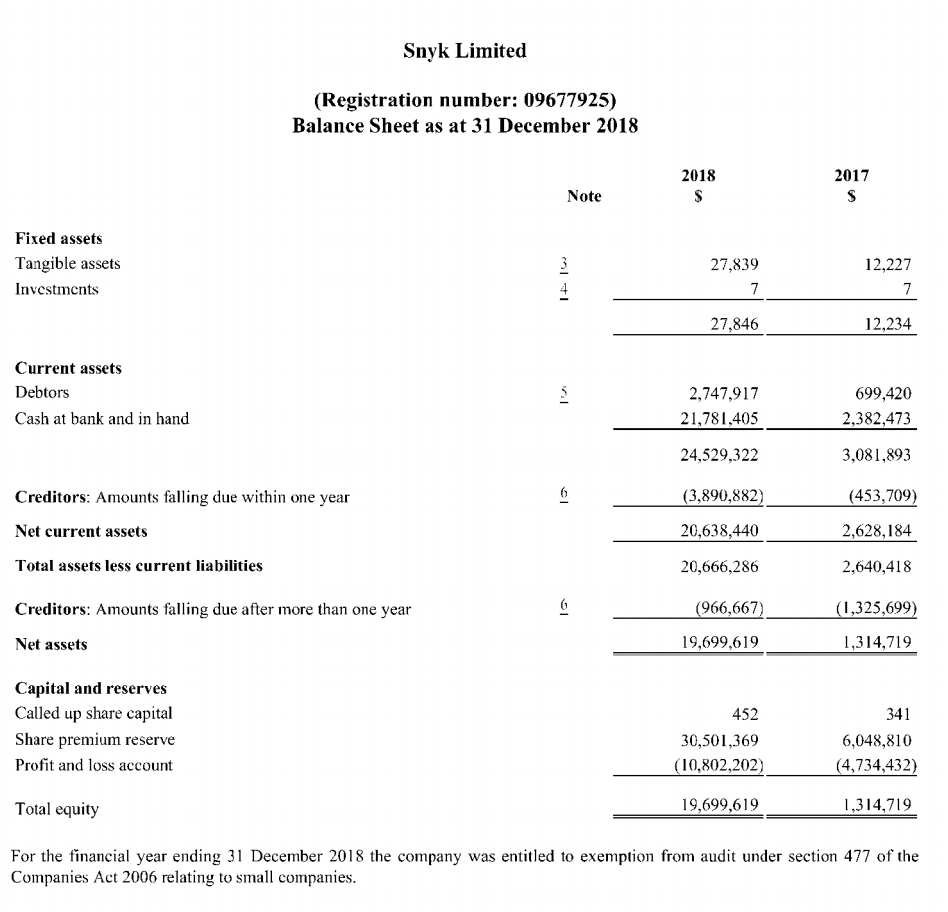
A company must meet at least two of the following conditions in order to submit abridged, micro company accounts:
- a turnover of £632,000 or less
- £316,000 or less on its balance sheet
- 10 employees or less
An example of micro company accounts:
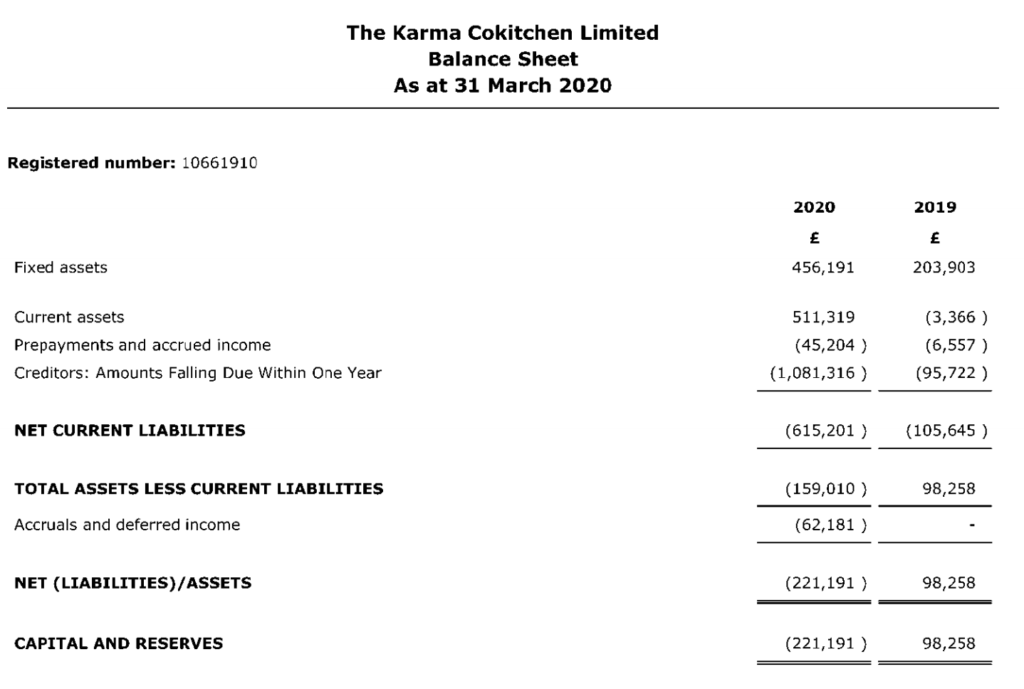
Can’t find the numbers that you’re looking for?
Some of the commonplace figures used for financial analysis and due diligence of a company will require calculations on your part. EBITDA (Earnings before interest, taxes, depreciation & amortization), for example, is commonly used to assess the financial position of a company. But this figure isn’t required for reporting.
There are, however, lots of clever searches you can do using the financials that are available to get round the lack of profit and loss figures, once the accounts are in a searchable format.
To save time for our subscribers, we’ve calculated this figure, along with others like pre-tax profit margin, return on capital, and company valuations, where possible.
We also calculate our own data points. For example, our stages of evolution denote the growth of a company, which many of our subscribers use as proxies for financial data that is lacking in abbreviated accounts.
When do companies file their annual accounts?
Companies are given an accounting reference date (ARD) upon incorporation, which marks the end of their accounting period. This date will be the last day of the month in which the company was incorporated. For example, a company registered on 5th November 2019 will have its first ARD on 30th November 2020.
Most private limited companies are required to file accounts within 9 months of this date. If not, they may face penalties.
Confirmation statement (Form CS01)
Confirmation statements provide an overview of a company including its registered office address, SIC codes, directors and their personal details, and a breakdown of shareholders and the number of shares they own. It’s used to ensure that the public register is up to date and accurate, and needs to be filed at least once every 12 months—even if nothing has changed from the previous year.
This form replaced the annual return form (AR01) in June 2016.
On the Beauhurst platform, we display ownership filings in a far more intuitive way, and even allow you to see how cap tables have changed between years. As with all of our data points, ownership filings can also be exported to a spreadsheet.
Events-based filings
As well as filing annual returns and confirmation statements, companies are also required to submit filings upon or promptly after certain events. These span all kinds of activities, and are a great way of finding out more detail about a company through public sources.
These events include:
- Change in company name (CERTNM)
- Change of registered office address (AD01)
- Newly appointing (AP01) or terminating the appointment (TM01) of a director
- Changes to details of a director (CH01), secretary (CH03) or Person with Significant Control (PSC04)
- A second filing of a previously delivered document (RP04)
- Reorganisation of the company’s share capital (various)
- Updates to the company’s articles of association (MA)
- Allotment of new shares (SH01)
This final event is one of the most important for us here at Beauhurst. These filings show all the details about equity investments, whether they’ve already been announced to the media or not.
We use proprietary tech to extract the data from these filings and analyse whether a genuine investment has been made (sometimes these forms may have been used in the reallocation of existing shares or change to share structure).
Our in-house team of data analysts then manually verify these records and add them to the Beauhurst platform. This process means we can track all genuine equity investments made into UK companies, something which no other data provider offers.
When do companies file these documents?
Deadlines differ between each type of filing, but they are usually required to be filed between 14 and 30 days from the event.
Companies House people profiles
Click through to the people tab on a company profile and you’ll see a list of all the company officers. All companies are required to appoint one or more directors aged 16 or above, with the minimum number depending on the type of company.
This usually includes the company founders or senior decision makers.
Along with the role of the officer, you’ll also see some of their personal details including their date of birth, date of appointment, nationality, and country of residence.
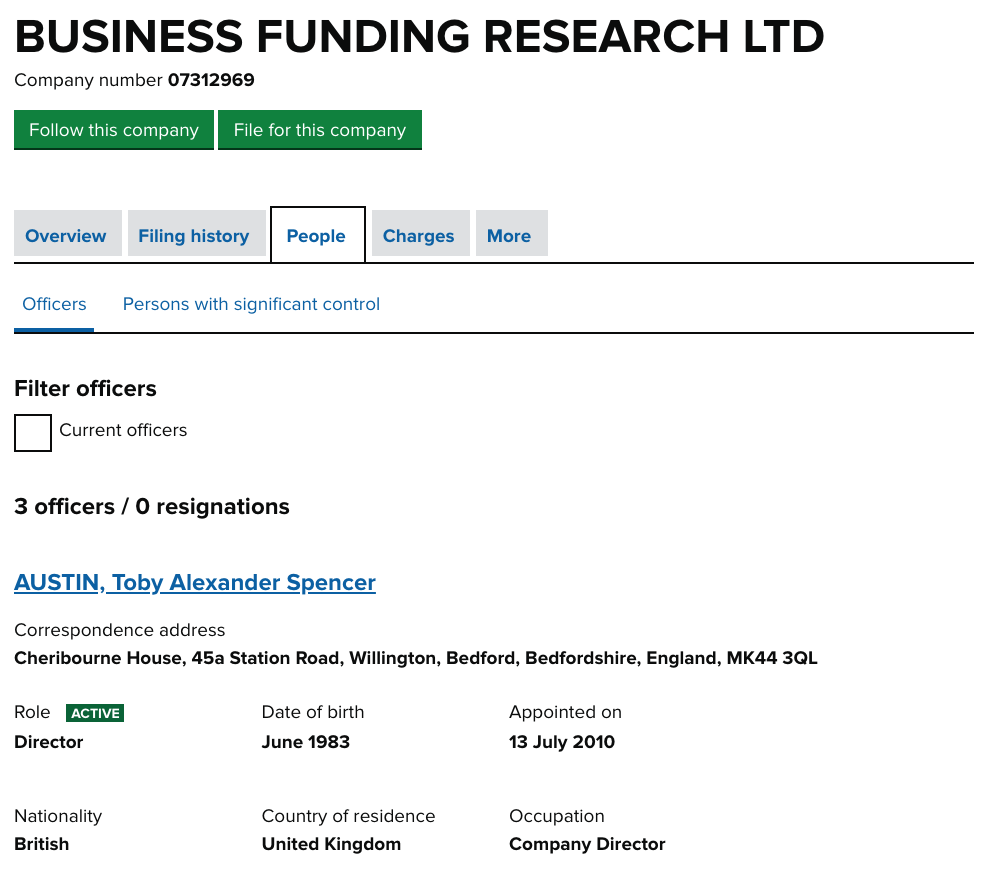
Click the person’s name and you’ll be taken to an individual profile. Here you’ll see all the other companies that they’re associated with on Companies House.
Companies House director profiles
Director profiles show you all the basic details of a person associated with a registered company. Along with their date of birth, nationality, and country of residence, you can also see details on all of their relevant positions. This includes the corresponding company status, and their relevant role and occupation, appointment date and resignation date (if applicable).
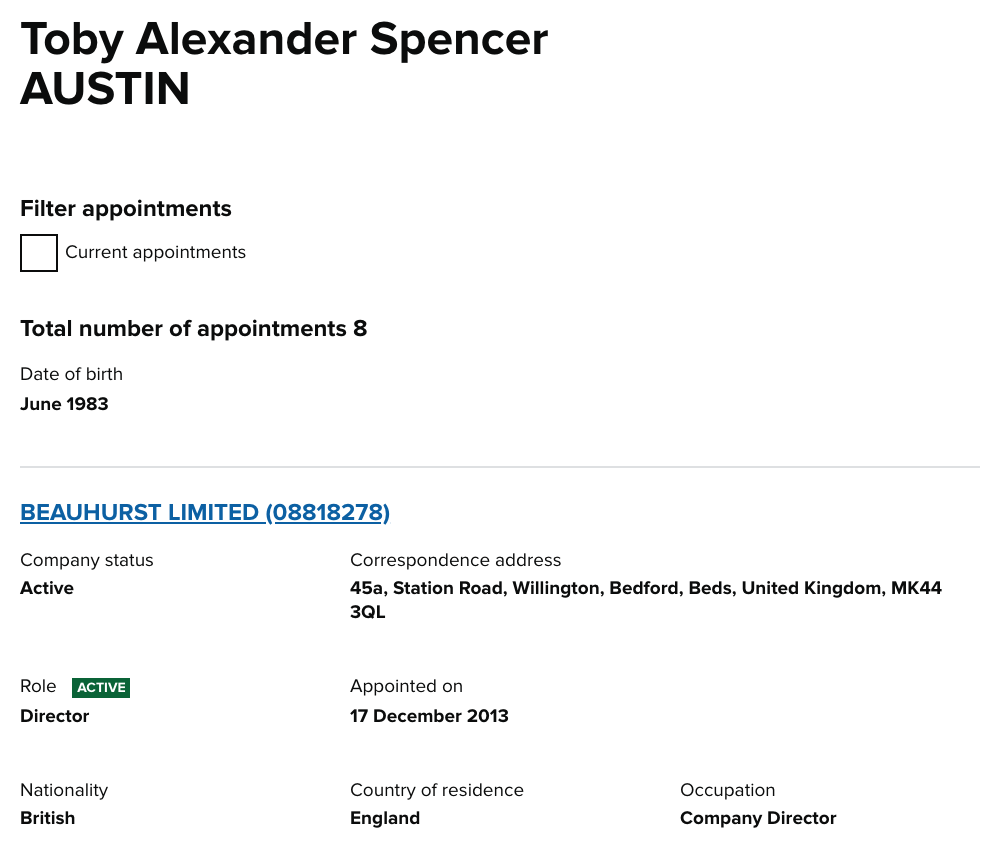
At Beauhurst, we present this data in a much clearer format, building a profile for each person that is connected to a high-growth company, and even mapping the connections between them. This is available as part of our Networks add-on.

Things to be cautious about…
As ever, there are a couple of things you need to be aware of if you’re sourcing information from director profiles. Firstly, a lot hangs on the importance of their name, and how it has been recorded. For example, if a founder enters his or her full name, including their middle name, in the filings for one directorship, but omits their middle name in filings for another directorship, then they will appear as two separate profiles on Companies House. This means that you may not be looking at the full picture.
Even when names are spelt the same, the profiles may not match up. Take Eileen Burbidge, for example, a partner at Passion Capital and Non-Executive Director at numerous startups. At the time of writing, she has nine separate profiles on Companies House, all with a different number of appointments.
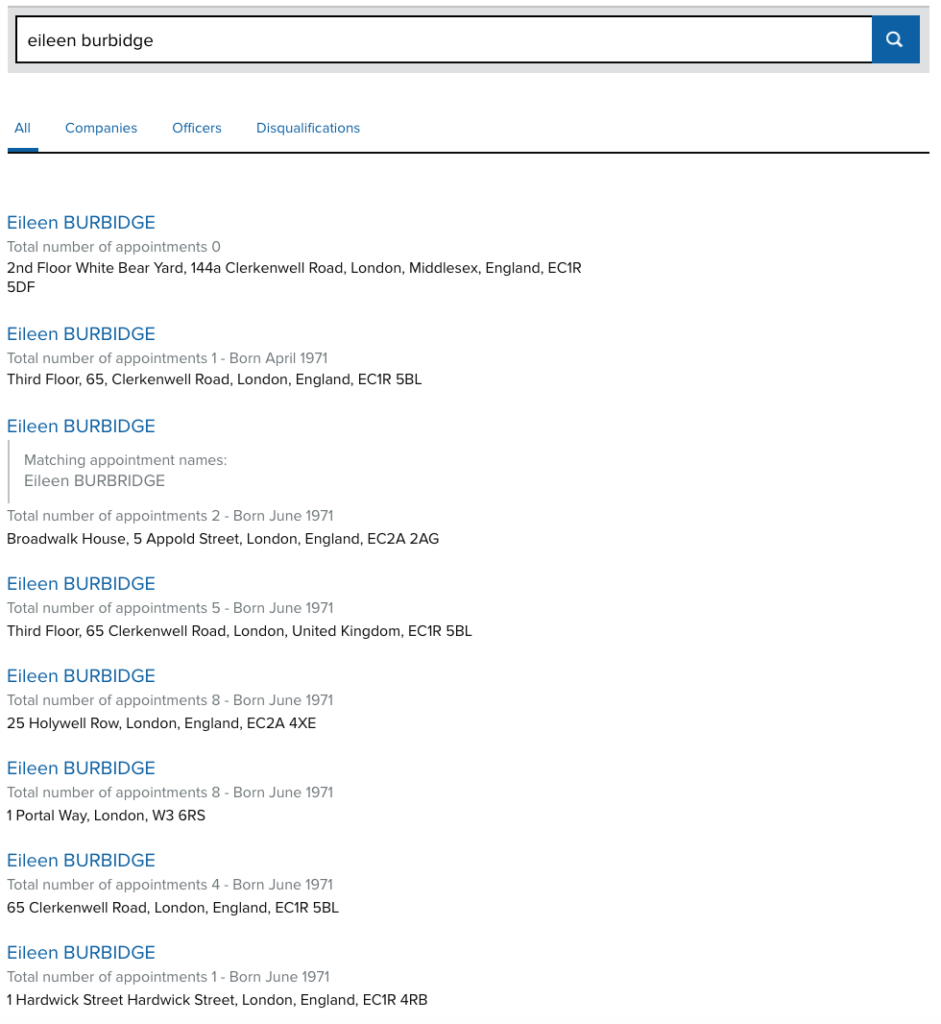
At Beauhurst, we use machine learning algorithms to get around this problem. Our proprietary tech spots multiple profiles for the same individuals and merges them accordingly. This means you’re always seeing the complete data on the people behind the UK’s most ambitious businesses.
Company roles
Whilst Companies House does tell you the ‘role’ of each person in each company they’re active in, they’re pretty bland descriptors. The title of ‘Director’ might have a legal standing, but doesn’t provide any detail on their role in the day-to-day running of the company. You’ll likely need to dip into Linkedin to find out more about the person (if they have a profile).
At Beauhurst, we collect all the information about the exact role of directors, as well as all C-Suite employees. This includes their formal position (e.g Production Engineering Director) as well as the job function (e.g. Strategy and Engineering). This means you can find out more about what the person actually does without having to dig through other data sources.
Shareholdings
One of the things you may be hunting for through director profiles is a sum of their shareholdings in each company. To do this, you’ll need to go into each company profile, go to the filings tab, and locate the latest confirmation statement. Again, these PDFs are saved as images, so you’ll have to look through the whole document to find the precise information you need. Make sure you look through the whole document, as one individual, business or investment firm may hold shares in multiple different classes.
Want to compare the change in shareholdings over time? You’ll have to download all the relevant PDFs and compare totals across different confirmation statements.
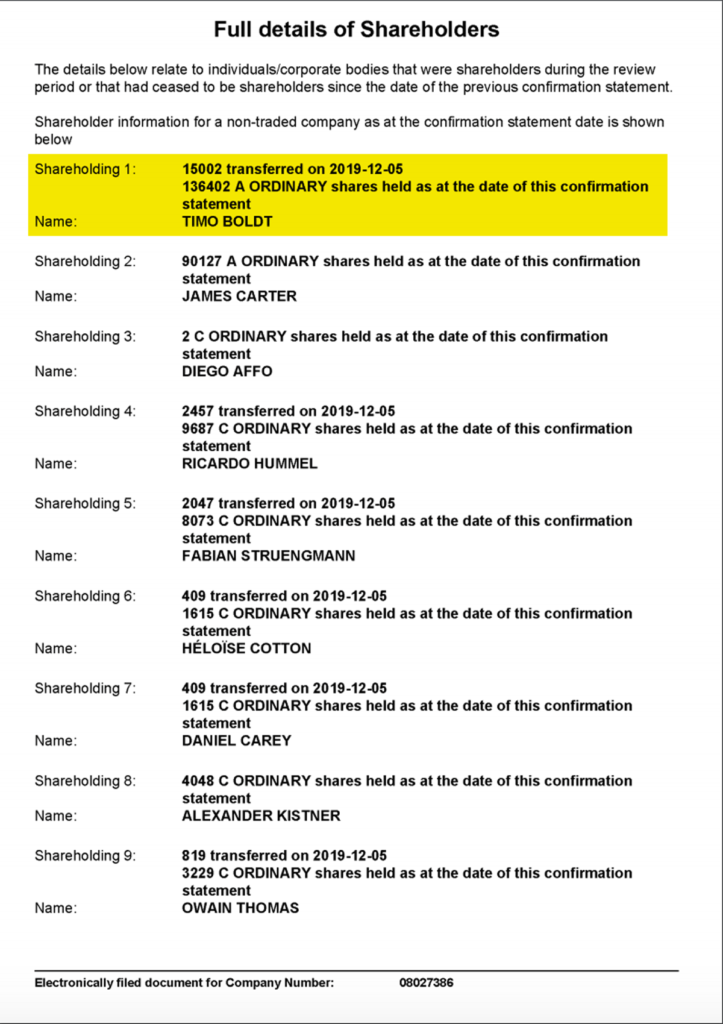
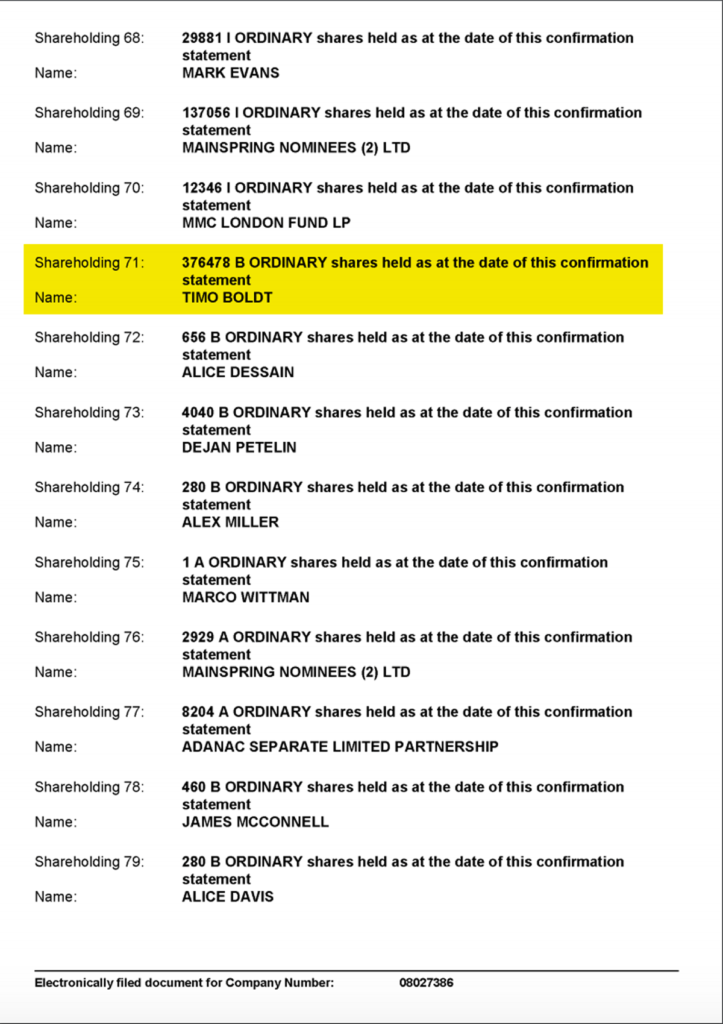
At Beauhurst, we pick out all of the shareholder information and place it within the individual’s profile, so you can see it all in one place. You can also see the change in shareholdings over time, to see if someone is becoming more or less involved in a company (or is being diluted by other shareholders).

Companies House search: what can you find?
Companies House company search
The Companies House company search is, frankly, very limited. The only things you can search for to find a company is their company name or company number. Or, if you know the name of a director you could indirectly find the business via their profile.
The main limitations…
Importantly, there is no way to search for a company based on the contents of their filings. This means that Companies House is only good for checking a company that you already know about. It’s not an appropriate way of discovering new companies based on a list of criteria.
At Beauhurst, we hold all the data that you can find on Companies House, and have structured it in a more intuitive and searchable format. So instead of just searching by company name, you can search by their status, SIC codes, financial milestones, location, and more. We also hold hundreds of extra data points on the high-growth companies that we actively track.
Things to be cautious about…
It’s often difficult to find the right company, and ensure that you’re looking at all the relevant information, because many businesses have complicated group structures. They may operate under one name but file their financials under another. For example, we trade under the name “Beauhurst”, which does have it’s own company profile, but we submit our filings under “Business Funding Research Ltd”.
Unfortunately, it can be a bit of a wild goose chase to figure out a corporate structure—in some cases, you may be looking at a subsidiary of a company, and not the whole business. Confirmation statements would show that one company is owned by another, but you’d have to check through the documentation of the whole group to make sure you’re looking at the right entity, and not just a subsidiary.
In other cases, a company may be trading under a completely different name than the one that appears on Companies House. For example, you’ll get no results by searching “Gousto”, because the ingredient delivery unicorn is registered under the name “SCA Investments Limited”.
At Beauhurst, we collect a comprehensive profile on a business, its people, and where they’re operating, all under the name of the “common sense” company. We also map out each company’s corporate structure. This means you can understand the full story of a company, rather than just a legal entity that has to file accounts.
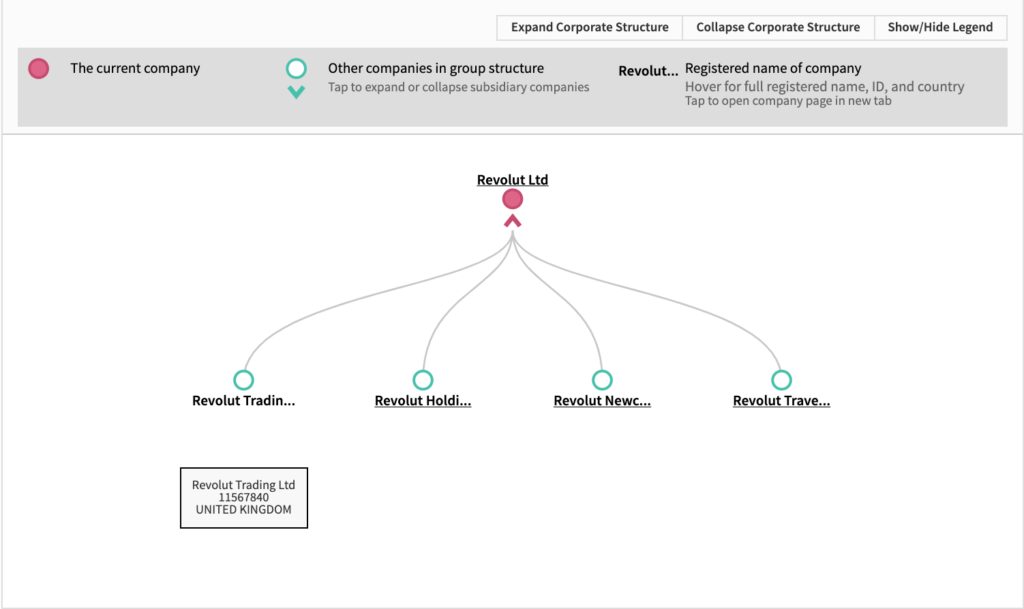
Companies House director search
As with company search, the Companies House Director search is similarly limited. The only way to find a director is through their name. It’s not possible to look up a director based on their address, nationality, date of birth, or the position they have within a certain company (although you could find this out via a company search).
As we mentioned above, you’ll need to make sure that you have the complete picture by checking if there are any alternative profiles for the same individual.
Companies House services
Companies House is a cost-effective way to perform basic due diligence on a company or individual at a company.
You can get most details about a company for free, including:
- Registered address
- Date of incorporation
- Current and resigned officers
- Document images
- Mortgage charge data
- Insolvency information
You can also set up free email alerts to tell you when Companies House accepts new filings for any given business. The email alert will include a link to the filing history of the company, where you can download the document for free.To follow a company, you’ll need to register an email add and password with Companies House Service (CHS). Then, click ‘Follow this company’ on any company profile.

You can also find this functionality (plus a whole lot more) on the Beauhurst platform. Curate your own ‘Collections’ of companies and receive alerts when they submit new filings. You can also be notified of any category of data on our tracked companies, funds and individuals, whether they have changed office location, secured a fundraisings or gone through an exit event. Choose the days and frequency with which you’d like to receive these emails.
What is Companies House Beta?
Company House Beta was launched in 2015 as an extension of free services and documentation, that allowed for the basic search of company and director names. Companies House Beta was always a trial service, and has now been fully launched at https://find-and-update.company-information.service.gov.uk/. This new address is where you can access company and director profiles.
What is Companies House WebCHeck?
Companies House WebCHeck service is a legacy service with information on 2 million UK companies. Similarly to the updated Companies House Service, you could find the following company information on WebCHeck:
- basic information including company type and registered office address
- the nature of business or standard industrial classification (SIC)
- company status, such as ‘live’ or ‘dissolved’
- date of last accounts or confirmation statement filed
- date of next accounts or confirmation statement due
- previous company names
- current officer details
- Most of the information is free, but you’ll need to register an account and pay a small fee of £1 for certain documents. You can also use Companies House WebCHeck in order to find disqualified directors. Search for directors by name and you’ll be able to access the following data:
- name and address
- date of birth
- nationality
- number of current disqualifications
- period of disqualification
- reason for disqualification
Use this link to access and login to Companies House WebCHeck.
Transform your sales strategy in 2022.
Get access to unrivalled data on all the companies you need to know about, so you can approach the right leads, at the right time.
Book a 40 minute demo today to see all of the key features, as well as the depth and breadth of data available on the Beauhurst platform.
An associate will work with you to build a sophisticated search, returning a dynamic list of organisations matching your ideal client.